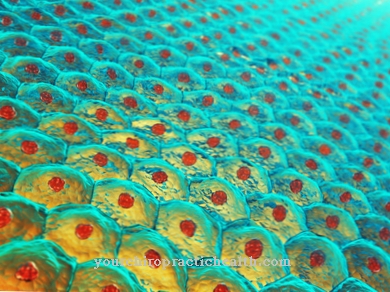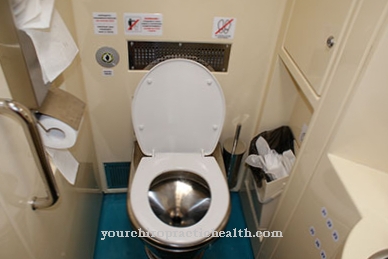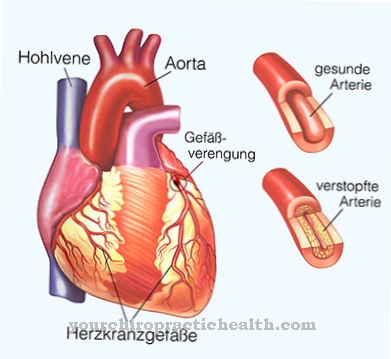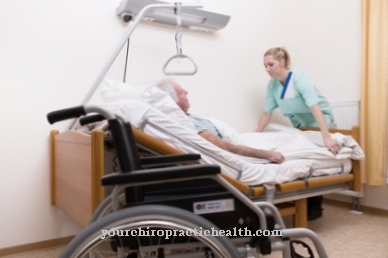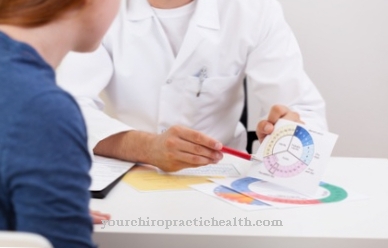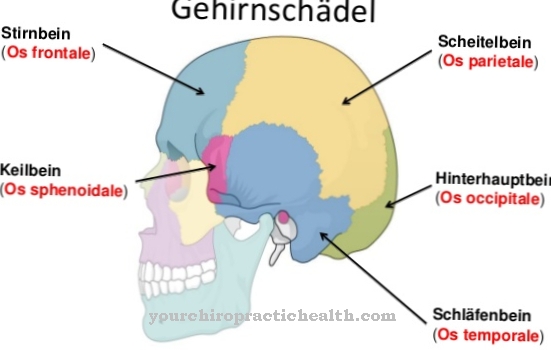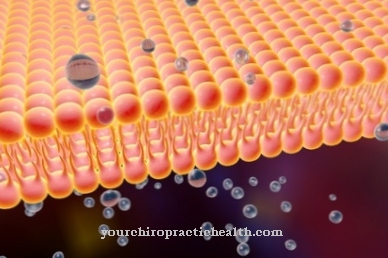Of the Rigor is a stiffness of the muscles that is subject to the control of the central nervous system and comes about through a simultaneous activation of muscles and their opponents. Rigorous is the symptom of extrapyramidal or pyramidal lesions in the CNS and can thus be associated with Parkinson's disease, for example. The therapy consists mainly of physiotherapy and occupational therapy.
What is rigor?

© high_resolution - stock.adobe.com
The muscles have a basic tension, which is also known as the resting tone. In the resting state, skeletal muscles are neither contracted nor completely relaxed. In a so-called rigor, the basic tension of the skeletal muscles is increased. The result is muscle rigidity or stiffness of the muscles.The rigor is based on a centrally controlled and simultaneous activation of the individual muscles and their antagonists.
The opponents of individual skeletal muscles are referred to as such. The muscle activation during rigor thus corresponds to an agonist-antagonist co-activation. In addition to a feeling of stiffness, patients with rigor often describe pulling paresthesia in the affected area. A special form of rigor is the so-called cogwheel phenomenon, in which the muscles of a passively moved extremity suddenly give way. The cogwheel phenomenon refers to disorders in the extrapyramidal system of the central nervous system.
causes
The causes of all forms of rigor are to be found in the central nervous system. Muscles have a certain basic tension that is regulated by different areas of the central nervous system. In addition to the pyramidal system, the extrapyramidal system is involved in this regulation.
All muscle information for the contraction of the muscles and muscle groups travel to the target organs via the cerebral cortex-spinal cord pathways. These tracks correspond to the pyramidal tracks, which are combined in the pyramidal system. Movement information can also be passed extrapyramidal and thus reach the spinal cord in a different way. The pyramidal and extrapyramidal systems interact with one another.
In most cases, rigor is preceded by dysfunction in the extrapyramidal system. The gear wheel phenomenon, for example, is often based on a dopamine deficiency and the resulting disorders, such as those that occur in the context of Parkinson's syndrome.
Rigor patients suffer from the main symptom of muscle rigidity. In the case of the gear phenomenon, this rigidity affects only passive movements. Other forms of rigors involve only active movements. The muscle stiffness ultimately leads to movement disorders and sometimes to coordination problems. One of the earliest signs of rigidity is decreased arm movement when walking.
In some cases, in addition to the rigidity, there is pain and abnormal sensation. The abnormal sensations are often due to the compression of sensitive nerves in the muscles. The movement disorders can in individual cases encourage a tendency to fall. Some of the patients develop camptocormia in the course of the rigors. Medicine understands this posture anomaly as an involuntary, active forward bending movement of the trunk area.
The cause of this phenomenon is the dystonic involuntary tension of the trunk flexors. This contraction increases especially when the body is upright, so that camptocormia usually occurs while standing. All other symptoms depend on the particular cause of the rigor. In the context of Parkinson's, for example, resting tremors and akinesia are among the most relevant symptoms.
You can find your medication here
➔ Medicines for muscle weaknessDiseases with this symptom
- Parkinson's
- multiple sclerosis
Diagnosis & course
The diagnosis of rigor is made by measuring the resting tone. For example, an EMG can be used for the measurement, which makes the voltage state objectifiable. In addition, a neurological examination takes place as part of the diagnosis. In this examination, the rigor is demonstrated on the lying or sitting patient. This proof is particularly successful with the gear wheel phenomenon.
The doctor passively moves the individual joints and asks the patient to relax the muscles. In the event of rigidity or a cogwheel phenomenon, the doctor feels the waxy-looking rigidity of the muscles in the form of a consistently tough resistance. In contrast to spastic symptoms, the resistance does not depend on the speed of movement.
If the patient actively moves the extremity on the other side, the resistance on the passively moved side increases. In the case of the cogwheel phenomenon, the rigor in this investigation is characterized by interruptions. In order to identify the primary cause of the rigor, the doctor then initiates imaging procedures, among other things. The prognosis depends on the cause of the rigor.
Complications
Muscle stiffness or rigidity mainly arises in the context of Parkinson's disease. Another possible complication with Parkinson's is so-called freezing, in which the person concerned freezes in the middle of movement. On the contrary, excessive, unwanted movements of the arms and legs or the trunk can occur (hyperkinesia), which increases the risk of injury to the person affected and to the environment.
Furthermore, Parkinson's patients can experience circulatory disorders, so that, for example, lying down to standing up can lead to severe dizziness and even unconsciousness. In addition, the affected person can weaken the bladder or rectum, making them incontinent and requiring care.
In addition, Parkinson's disease can lead to depression due to the impairment of quality of life. This can lead to an increase in alcohol and drug consumption, and depressives are also prone to suicidal thoughts. A rare and dreaded complication of Parkinson's disease is the akinetic crisis.
With this, the symptoms worsen and the person concerned suffers from total muscle stiffness or extreme rigidity. This can lead to a complete inability to move, which can also impair the speech and respiratory muscles. This can also lead to overheating of the body.
When should you go to the doctor?
In order to get a correct diagnosis, sufferers should contact a doctor if rigor is suspected. Self-diagnosis using tests or checklists from the Internet is not sufficient. Usually, patients first contact their family doctor. If necessary, the family doctor can then issue a referral to the specialist.
If the symptom reappears, patients with Parkinson's should also inform their treating physician about the appearance of the rigor. This is usually a neurologist or psychiatrist.
In Germany, however, patients do not necessarily need a referral to see a neurologist. Depending on how good the medical care situation is on site, the waiting times for an appointment can vary greatly. An appointment with the family doctor is often quicker and can in some cases allow an initial assessment of the symptoms.
In some cities there are also special outpatient clinics, which are often connected to a larger clinic. Some of these specialized treatment centers also schedule appointments for diagnosis and treatment for suspected Parkinson's disease.
Since rigor is a core symptom of Parkinson's, a professional diagnosis by a doctor makes sense in any case.
Doctors & therapists in your area
Treatment & Therapy
The therapy of rigors also depends on the primary cause of the disorder. In any case, physiotherapy and occupational therapy are included in the therapy. A causal therapy cannot take place. Every rigor has a central nervous cause and damage to the central nervous system is in most cases irreversible to a certain extent. Occupational therapy and physiotherapy are therefore symptomatic rather than causal treatment.
In forms of therapy, the aim is at least to alleviate the rigor or to help the patient deal with the symptom. In occupational therapy, for example, the patient learns how to use possible aids so that they can find their way through everyday life independently for as long as possible, even with severe rigors. Above all, everyday movement sequences are trained as part of the therapy. Under certain circumstances, drug treatment steps that induce the central nervous system to reduce its tone may also be considered.
Outlook & forecast
In the case of a rigor, the prognosis essentially depends on the cause of the muscle stiffness. If the rigor is based on Parkinson's disease, the symptoms can be alleviated by physiotherapy and occupational therapy, but damage that has already occurred is in most cases irreversible. The prospect of a full recovery is therefore not given, but other symptoms can at least be alleviated through early measures.
In the course of the disease there are usually further symptoms such as a changed gait behavior, a lack of blinking or a decrease in voice volume, which can accordingly worsen the prognosis. Corresponding complaints develop with the course of the underlying Parkinson's disease and increase in intensity and spread until it finally comes to severe paralysis and later death of the person concerned.
The prospect of healing is given in the case of rigor as a result of an injury or an accident. Surgical interventions can then possibly restore the original muscle performance without causing any secondary symptoms. The first signs of rigor should be clarified promptly by a doctor due to the severity of the course.
You can find your medication here
➔ Medicines for muscle weaknessprevention
Rigor is the symptom of pyramidal or extrapyramidal damage to the central nervous system. This means that rigor can only be prevented to the extent that lesions in the central nervous system can be prevented. For example, there are no preventive measures available against diseases such as multiple sclerosis. For this reason, rigors can never be completely prevented.
You can do that yourself
During a rigor, it can be helpful to do exercises outside of the physical therapy units. The prerequisite for this, however, is that the exercises are carried out properly and that there is a consultation with the treating therapist beforehand. Otherwise there is a risk of exacerbation of symptoms or overload. Only properly performed exercises are able to improve the everyday life of those affected.
Nonetheless, the opportunities to take action on a rigor yourself are quite limited. It is only possible to supplement or support existing treatment approaches. Since rigors are not infrequently associated with irreversible damage to the central nervous system, those affected have to adapt their everyday life to the illness. This has to be accepted. Everyday movements should be carried out despite the restrictions. If aids are to be used, they must be mastered.
In addition, psychological aspects must also be considered in the everyday life of those affected. Finally, the diagnosis of rigor brings with it numerous changes. Since these are mostly irreversible, the path of acceptance is usually the easiest. It is therefore advisable to also mentally come to terms with the new living conditions. Consultation with a psychologist or psychiatrist can help.

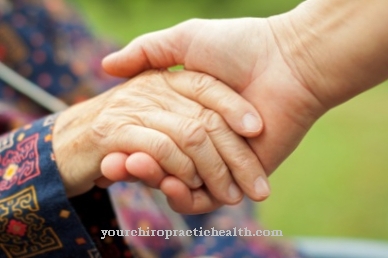



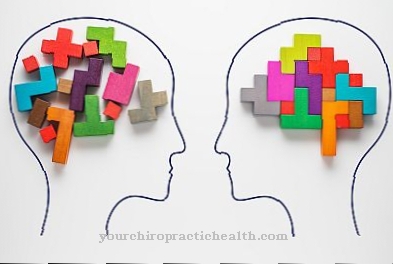


.jpg)
